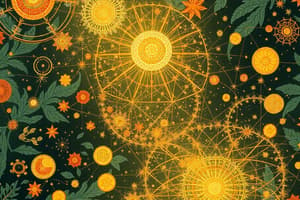Podcast
Questions and Answers
What is the study of matter and its properties, as well as how matter changes, called?
What is the study of matter and its properties, as well as how matter changes, called?
- Geology
- Chemistry (correct)
- Biology
- Physics
Which of the following describes matter?
Which of the following describes matter?
- Anything that has volume but no mass
- Anything that has mass and takes up space (correct)
- Anything that has mass but does not take up space
- Energy that can be converted into other forms
What is a substance with a defined composition called?
What is a substance with a defined composition called?
- Mixture
- Solution
- Element
- Chemical (correct)
Which state of matter has a fixed shape and volume?
Which state of matter has a fixed shape and volume?
Which of the following is an example of an element?
Which of the following is an example of an element?
What is a combination of two or more substances in which each substance retains its distinct identity called?
What is a combination of two or more substances in which each substance retains its distinct identity called?
What is a mixture with uniform composition throughout called?
What is a mixture with uniform composition throughout called?
Which of the following is a physical property?
Which of the following is a physical property?
Which of the following is an SI unit for mass?
Which of the following is an SI unit for mass?
What is the closeness of a measurement to the true value called?
What is the closeness of a measurement to the true value called?
In the number 0.00502, how many significant figures are there?
In the number 0.00502, how many significant figures are there?
What is an atom or molecule that has gained or lost one or more electrons called?
What is an atom or molecule that has gained or lost one or more electrons called?
What is the number of protons in the nucleus of an atom called?
What is the number of protons in the nucleus of an atom called?
What is a homogeneous mixture of two or more substances called?
What is a homogeneous mixture of two or more substances called?
Flashcards
Chemistry
Chemistry
The study of matter and its properties and how matter changes.
Matter
Matter
Anything that has mass and takes up space.
Chemical
Chemical
A substance with a defined composition.
Properties
Properties
Signup and view all the flashcards
Solid
Solid
Signup and view all the flashcards
Elements
Elements
Signup and view all the flashcards
Compounds
Compounds
Signup and view all the flashcards
Mixture
Mixture
Signup and view all the flashcards
Homogeneous Mixture
Homogeneous Mixture
Signup and view all the flashcards
Heterogeneous Mixture
Heterogeneous Mixture
Signup and view all the flashcards
Physical Properties
Physical Properties
Signup and view all the flashcards
Chemical Properties
Chemical Properties
Signup and view all the flashcards
Intensive Property
Intensive Property
Signup and view all the flashcards
Extensive Property
Extensive Property
Signup and view all the flashcards
Accuracy
Accuracy
Signup and view all the flashcards
Study Notes
- Chemistry is the study of matter, its properties, and how it changes.
- Matter is anything with mass that occupies space.
- A chemical has a defined, consistent composition.
- Properties differentiate matter types.
States of Matter
- Solids have fixed shape and volume.
- Liquids have definite volume but assume the shape of their container.
- Gases lack definite shape and volume.
Composition of Matter
- Matter consists of elements and compounds.
- Elements cannot be broken down into simpler substances by chemical means.
- Elements are made of atoms with the same number of protons.
- Compounds contain two or more elements chemically combined in fixed proportions.
- Compounds can be broken down into elements chemically.
- Mixtures combine two or more substances that retain their identities.
- Homogeneous mixtures have uniform composition.
- Heterogeneous mixtures have non-uniform composition.
Physical and Chemical Properties
- Physical properties are observable without changing the substance's identity (e.g., color, melting point, boiling point).
- Chemical properties describe how a substance changes or reacts to form other substances.
- Intensive properties do not depend on the amount of matter (e.g., temperature).
- Extensive properties depend on the amount of matter (e.g., mass, volume).
Measurement
- Quantitative properties are measurable, using SI units.
- Mass is the amount of matter (kilogram, kg).
- Length is the distance between two points (meter, m).
- Time is the interval between events (second, s).
- Temperature measures hotness or coldness (kelvin, K).
- Amount of substance (mole, mol).
- Electric current (ampere, A).
- Luminous intensity (candela, cd).
- Volume is length cubed, in cubic meters (m3), commonly liters (L) or milliliters (mL) in chemistry.
Uncertainty in Measurement
- All measurements contain some degree of uncertainty or error.
- Accuracy is the closeness of a measurement to the true value.
- Precision is the closeness of repeated measurements of the same quantity.
Significant Figures
- All digits of a measured quantity are significant, including the last uncertain digit.
- Non-zero digits are always significant.
- Zeros between non-zero digits are significant.
- Zeros to the left of the first non-zero digit are not significant.
- Zeros at the end of a number and to the right of the decimal point are significant.
- Zeros at the end of a number but to the left of a decimal point may not be significant.
- In multiplication and division, the result has the same number of significant figures as the original number with the fewest significant figures.
- In addition and subtraction, the answer has the same number of digits to the right of the decimal point as the original number with the fewest digits to the right of the decimal point.
Dimensional Analysis
- Dimensional analysis is a problem-solving method using units in calculations.
- Conversion factors change one unit to another.
Atoms, Molecules, and Ions
- All matter consists of atoms.
- An atom is the smallest particle of an element retaining its chemical properties.
- A molecule is two or more atoms held by chemical bonds.
- An ion is an atom or molecule that has gained or lost electrons.
Atomic Structure
- Atoms contain protons, neutrons, and electrons.
- Protons are positively charged and located in the nucleus.
- Neutrons have no charge and are located in the nucleus.
- Electrons are negatively charged and orbit the nucleus.
Atomic Number, Mass Number, and Isotopes
- Atomic number (Z) is the number of protons in an atom's nucleus.
- Mass number (A) is the total number of protons and neutrons in an atom's nucleus.
- Isotopes are atoms of the same element with different numbers of neutrons.
The Periodic Table
- The periodic table arranges elements by increasing atomic number.
- Similar properties define element groups.
- Vertical columns are groups on the periodic table.
- Horizontal rows are periods on the periodic table.
- Metals are lustrous, conduct heat and electricity well, and are typically solid at room temperature.
- Nonmetals are dull, poor conductors, and can be solids, liquids, or gases at room temperature.
- Metalloids have intermediate properties between metals and nonmetals.
Chemical Formulas and Nomenclature
- Chemical formulas represent compound composition.
- Molecular formulas show the exact number of atoms of each element in a molecule.
- Empirical formulas show the simplest whole-number ratio of atoms in a compound.
- Naming compounds follows specific rules based on the type of compound.
- Ionic compounds are named by stating the cation first, followed by the anion.
- Covalent compounds are named using prefixes to indicate the number of atoms of each element.
Chemical Reactions and Equations
- Chemical reactions rearrange atoms and molecules, forming new substances.
- Chemical equations represent reactions with formulas and symbols.
- Balanced equations have the same number of each element's atoms on both sides.
Stoichiometry
- Stoichiometry is the quantitative study of reactants and products in chemical reactions.
- The mole is the SI unit for amount of substance (6.022 x 10^23 entities).
- Molar mass is the mass of one mole of a substance.
- Stoichiometric calculations use balanced equations to determine reactant and product amounts.
- The limiting reactant is completely consumed in a reaction.
- Percent yield is (actual yield / theoretical yield) x 100%.
Solutions
- Solutions are homogeneous mixtures of two or more substances.
- The solute is the substance being dissolved.
- The solvent is the substance doing the dissolving.
- Concentration is the amount of solute in a given amount of solvent or solution.
- Molarity (M) is moles of solute per liter of solution.
- Dilution reduces concentration by adding more solvent.
- Electrolytes dissociate into ions in water, creating conductive solutions.
- Non-electrolytes do not dissociate into ions in water; their solutions do not conduct electricity.
Acids and Bases
- Acids increase the concentration of H+ ions in water.
- Bases increase the concentration of OH- ions in water.
- pH measures acidity or basicity.
- Neutralization reactions combine an acid and a base to form a salt and water.
- Titration determines concentration by reacting a solution with a known concentration.
Gases
- Gases expand to fill any volume, are compressible, and have low densities.
- Pressure is force per unit area (Pascal, Pa).
- Gas laws relate pressure, volume, temperature, and amount of gas.
- Boyle's law: P1V1 = P2V2 (constant temperature and moles).
- Charles's law: V1/T1 = V2/T2 (constant pressure and moles).
- Avogadro's law: V1/n1 = V2/n2 (constant temperature and pressure).
- Ideal gas law: PV = nRT (R is the ideal gas constant).
- Dalton's law of partial pressures: total pressure equals the sum of individual gas pressures.
Studying That Suits You
Use AI to generate personalized quizzes and flashcards to suit your learning preferences.




